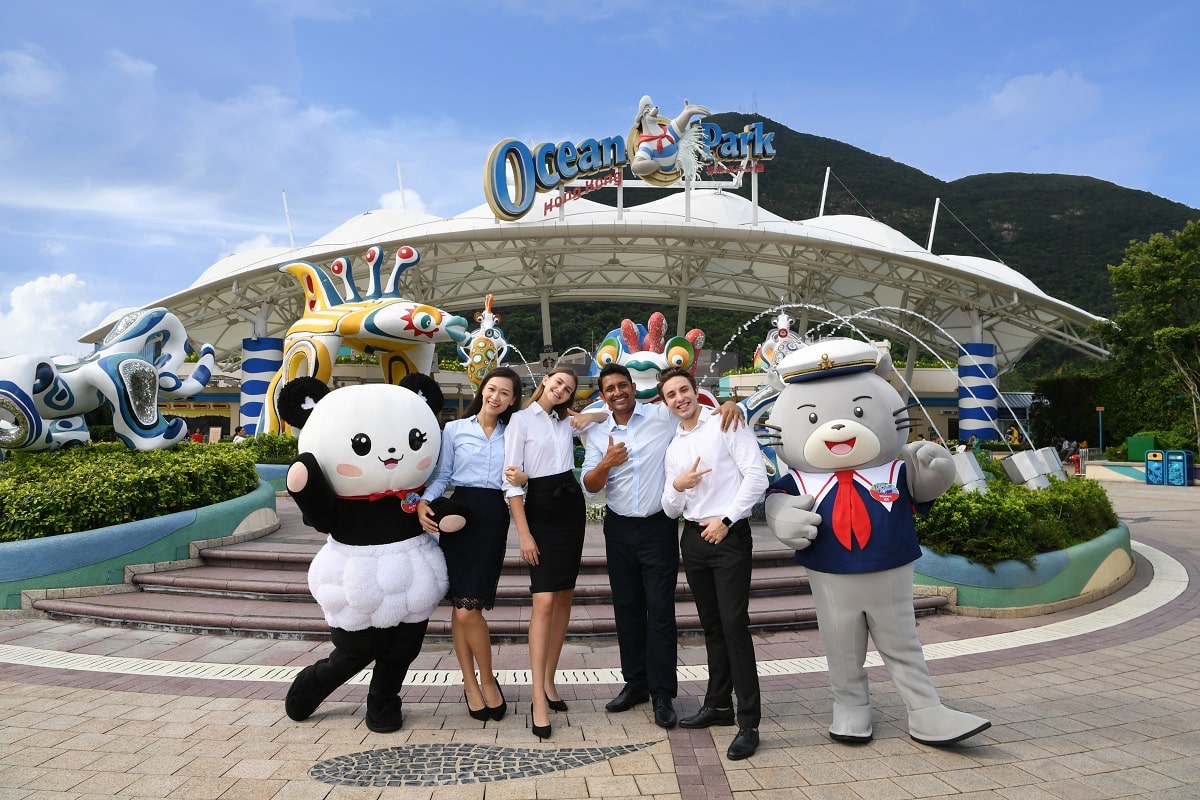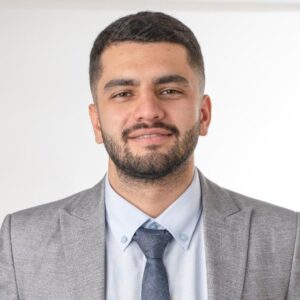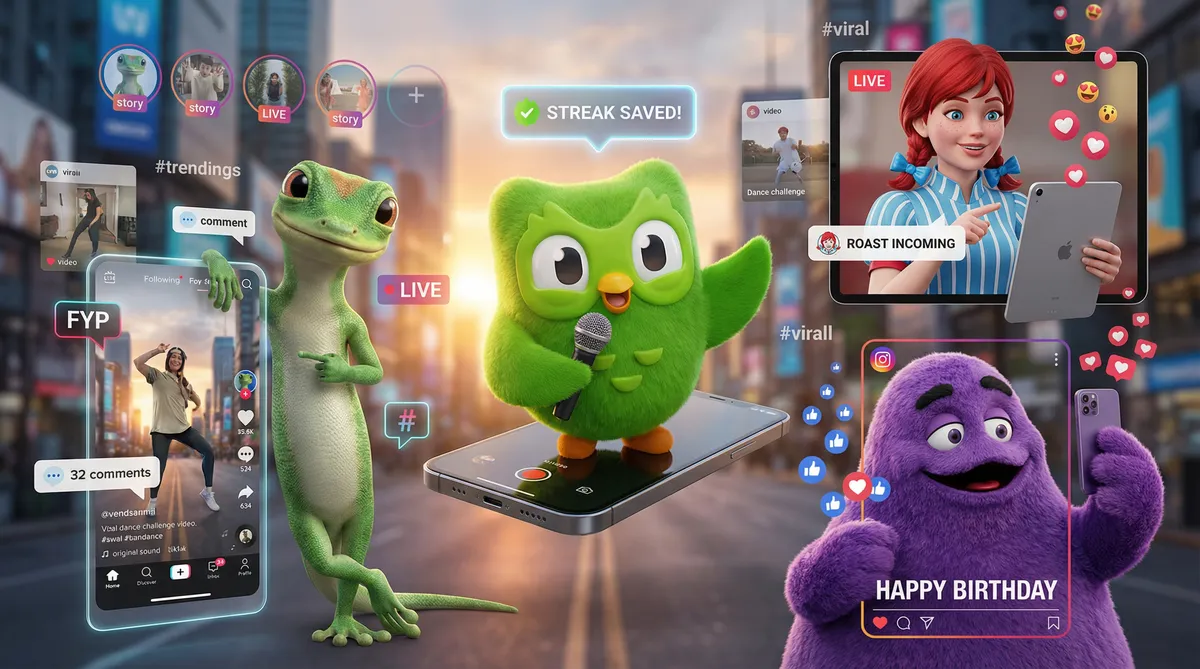
Digital distractions are at every turn; theme parks face the challenge of not only attracting visitors but also creating an unforgettable experience that resonates long after the day ends. The true key to success lies not just in attracting visitors but in maintaining a lasting connection with them. How do theme parks keep guests returning for more, creating that unbreakable bond that turns first-time visitors into lifelong fans?
This article explores multifaceted theme park advertising strategies. A central piece of this is leveraging the park’s beloved characters. To understand their advertising power, it’s essential to first know what brand mascots are. From there, we’ll cover everything from audience research to the latest in digital engagement.
Highlighting Successful theme park Advertising Campaigns
Yas Island Featuring Jason Momoa
Over the last two years, Yas Island has launched several successful advertising campaigns, significantly enhancing its global presence as a leading destination for leisure and entertainment. Notably, the campaigns have leveraged viral marketing strategies, engaging content, and celebrity endorsements to capture audience attention worldwide.
Their innovative approach has included campaigns such as “Stayin’ On Yas,” a homage to the Bee Gees’ disco classic “Stayin’ Alive,” and its follow-up “Yas Yas Baby,” inspired by Vanilla Ice’s track. These campaigns have not only gone viral but also creatively showcased Yas Island’s diverse attractions.
Another agency Created viral content for Yas Island. Their work includes the “Stayin’ On Yas” campaign, which became Yas Island’s most successful advertising campaign in its history. This campaign was developed with support from Dejavu and Starcom, highlighting Yas Island as a dynamic destination offering exhilarating experiences across a range of attractions.
In recent campaigns, Yas Island introduced the concept of a “Chief Island Officer,” with celebrities like Kevin Hart and Jason Momoa embodying the role in their respective campaigns. These campaigns effectively utilized the star power of celebrity endorsements, ensuring the island’s offerings remained the focal point, thus amplifying Yas Island’s appeal as a vibrant leisure and entertainment destination.
The “Yas Yas Baby” campaign, launched in the summer of 2022, built upon the success of the previous year’s campaign. Styled as a music video, it featured energetic performances across Yas Island’s iconic attractions, continuing to engage audiences with its innovative and entertaining approach.
These campaigns underscore Yas Island’s commitment to innovative marketing strategies, leveraging creative content, viral marketing, and celebrity endorsements to enhance its brand visibility and appeal on a global scale.
House of Nightmares at Gröna Lund
The “House of Nightmares” campaign for Gröna Lund, a theme park located in Stockholm, was a marketing effort surrounding the launch of a new horror attraction designed by the Sally Corporation, a leader in designing and building interactive dark ride attractions. The attraction, which opened on April 25, 2015, was themed around the story of Dr. Morphio, an American scientist and TV presenter from the 1940s who specialized in the nature of human subconscious and dreams. The narrative explores Dr. Morphio’s discredited experiments aimed at forcibly extracting dreams from human subjects to bring their nightmares to life.
The marketing efforts for the House of Nightmares included a multifaceted approach to build anticipation and attract visitors. This included a poster campaign, a zombie kiss-cam scare prank inside a movie theatre, and a commercial for the House of Nightmares that was deemed so frightening it was banned from airing before 9 pm. The attraction itself features animatronic characters, CGI video effects, live wire illumination, video projection, Pepper’s Ghost illusions, ultraviolet illumination, live performers, and various special effects designed to immerse visitors in a terrifying experience.
This campaign skillfully uses the thrill of fear, showcasing the park as an exhilarating destination for those seeking to face their fears in a controlled, fun environment. With this type of content, this brand keeps its connection with its audience in the long term.
Practical Strategy for Effective Theme Park Advertising
1. Audience Insight and Analysis
Universal Studios Hollywood is an iconic theme park located in Los Angeles, California, known for its immersive movie-themed attractions and experiences. Understanding its audience has been key to its continued success and popularity.
Universal Studios Hollywood conducts thorough demographic analysis to identify its target audience. Through market research, data analysis, and guest feedback, the park gathers insights into its visitors’ demographics, including age, gender, income level, interests, and geographic location.
Target Audience Identification
Based on demographic analysis, Universal Studios Hollywood identifies its primary target audience as families with children, teenagers, and young adults. These demographic groups are drawn to the park’s thrilling rides, immersive movie-themed attractions, and entertainment offerings.
2. Crafting Messages
Once the target audience is identified, Universal Studios Hollywood crafts messages that resonate deeply with them.
For families with children, the park emphasizes its family-friendly attractions, character meet-and-greets, and entertainment options suitable for all ages.
For teenagers and young adults, the park highlights its adrenaline-pumping rides, live shows featuring popular franchises, and nighttime events geared towards a more mature audience.
3. Choosing Channels
They select communication channels that effectively reach their target demographic. This includes traditional channels such as television commercials, radio ads, and print advertisements, as well as digital channels like social media and influencer partnerships. By leveraging a mix of channels, the park ensures that its messages reach the right audience at the right time.
4. Personalised Experiences
In addition to crafting messages and choosing channels, Universal Studios Hollywood personalizes the guest experience to cater to different segments of its audience. This may include offering VIP experiences for guests seeking a more exclusive and immersive visit, special packages for families with young children, and themed events tailored to specific interests or demographics.
Unique Theme Creation
Set your park apart with unique themes or characters, making it a standout choice for visitors seeking a one-of-a-kind experience. Every amusement park has lots of rides, vehicles, and stores, and all of them are the same until you have them. You can customize your theme park with that, and it can be anything. Like the European park in Germany, instead of creating a normal ride in your theme park, you can customize it and put your signature on it. Look at this video to get my point.
Instead of the normal ride, they created it by their characters, designing it with their characters:
Snorri the Octopus Dark Ride. Do you see? You can change the name because you have your characters, and it will be unique worldwide.
5. Local Engagement
Local engagement is a crucial aspect of theme park advertising strategy, as it involves building strong connections with the surrounding community to foster support and loyalty. By engaging with locals, theme parks can position themselves as integral parts of the community fabric, encouraging residents to become advocates and ambassadors for the park.
Disneyland Resort in Anaheim, California, provides an excellent example of effective local engagement strategies.
Community Events and Partnerships:
Disneyland Resort actively participates in and sponsors various community events in Anaheim and the surrounding areas. This includes sponsoring local festivals, charity fundraisers, and school events. By being present at these events, Disneyland demonstrates its commitment to the community and strengthens its ties with local residents.
Educational Initiatives
Disneyland Resort also engages with the local community through educational initiatives aimed at schools and youth organizations. These initiatives may include educational tours of the park, workshops on topics such as animation or storytelling, and scholarship programs for local students. By investing in education, Disneyland not only enriches the lives of local youth but also reinforces its role as a positive influence in the community.
Employment Opportunities
Disneyland Resort provides employment opportunities for thousands of local residents, ranging from entry-level positions to skilled roles in areas such as entertainment, hospitality, and management. By offering stable employment and career advancement opportunities, Disneyland contributes to the local economy and strengthens its relationship with the community.
Community Outreach and Support
In times of need, such as natural disasters or community crises, Disneyland Resort often steps up to provide support and assistance to local residents. This may include donations of funds, supplies, or volunteer hours to aid in recovery efforts. By being a reliable source of support during difficult times, Disneyland demonstrates its commitment to the well-being of the community.
Through its local engagement efforts, Disneyland Resort has become much more than just a theme park; it’s a beloved institution deeply intertwined with the fabric of the Anaheim community. By actively engaging with locals, Disneyland has cultivated a sense of pride and ownership among residents, who view the park as a source of pride and identity. This strong bond with the community not only drives local attendance and support but also enhances Disneyland’s reputation as a world-class destination.
For example, in this campaign of Splashdown Waterparks in Canada in North America, they position themselves with print ads to stay at the top of the minds of local people.
6. Digital Integration
Beyond regular posts, engage with your audience through meaningful content and interactive opportunities. Look at Ocean Park Hong Kong’s Instagram. They excel in content creation due to their unique identity, effectively marketing every ride of their waterpark and theme parks. They maintain a vibrant social community by regularly updating with new and surprising content, offering exclusive discounts, and promoting unique events and shows.
They give credit to their followers by mirroring their comments and thoughts, even sharing memorable moments of the audience on their social media.

Influencer Partnerships
Utilize the power of influencers to expand your reach and authenticity. Every visitor can become a micro-influencer. Utilize user-generated content on your own social media platforms, one of the best ways to grow your audience and give them credit. Every visitor should be a micro-influencer.

Interactive Website
An interactive website serves as a dynamic and engaging platform for showcasing the experiences and attractions a theme park offers. As the digital front door to the park, the website plays a crucial role in capturing visitors’ interest, providing essential information, and driving ticket sales.
Compelling Introduction
An interactive website goes beyond static images and text to provide visitors with an immersive preview of what awaits them at the park. Through interactive elements such as virtual tours, interactive maps, 360-degree videos, and multimedia galleries, the website offers a compelling introduction to the park’s attractions, shows, dining options, and special events.
Enhanced User Experience
An interactive website enhances the user experience by allowing visitors to explore the park at their own pace and delve deeper into areas of interest. Interactive features such as ride simulators, online reservations, and customizable itineraries empower visitors to plan their visit and make the most of their time at the park.
Engagement and Conversion
By incorporating interactive elements and engaging content, the website encourages visitors to spend more time exploring and learning about the park. This increased engagement enhances the visitor experience and increases the likelihood of conversion—whether it’s purchasing tickets, booking accommodations, or signing up for newsletters and promotions.
7. FOMO-Based Advertising
Fear of Missing Out” (FOMO) has become a powerful tool in marketing, especially for theme parks. FOMO-Based Advertising capitalizes on the innate human desire to be part of something exciting or exclusive. Theme parks often use this strategy to create urgency and drive ticket sales by highlighting limited-time offers, special events, or unique experiences that visitors won’t want to miss.
One way theme parks implement FOMO-Based Advertising is through limited-time promotions, such as discounted tickets for a specific date range or exclusive access to new attractions before they’re open to the general public. By emphasizing the limited nature of these offers, parks create a sense of urgency, encouraging potential visitors to act quickly to avoid missing out.
Additionally, theme parks use FOMO-Based Advertising on social media platforms by showcasing user-generated content from previous visitors enjoying their experiences at the park. This social proof serves to amplify FOMO among those who haven’t yet visited, compelling them to join in on the fun and create their own memories.
Furthermore, FOMO-based advertising extends to influencer partnerships, where popular social media personalities share their experiences at the park with their followers. Seeing influencers enjoying themselves at the park can spark FOMO among their audience, driving them to visit in hopes of experiencing the same excitement.
Overall, FOMO-based advertising leverages the fear of missing out to drive ticket sales and visitor engagement, making it a potent strategy for theme parks looking to attract guests in a competitive market.
8. Seasonal Campaigns and Storytelling
Seasonal campaigns and storytelling are integral to keeping theme parks top of mind for visitors throughout the year. Rather than relying solely on peak seasons, theme parks use seasonal campaigns to create excitement and drive attendance during off-peak times, such as holidays or school breaks.
One common approach to seasonal campaigns is to create themed events or promotions tied to specific seasons or holidays. For example, many parks host Halloween events featuring haunted houses, costume contests, and special nighttime shows. These events not only attract visitors during what would typically be a slower season but also provide an opportunity for the park to showcase its creativity and innovation.
In addition to themed events, seasonal storytelling plays a vital role in maintaining visitor interest year-round. Theme parks often weave seasonal narratives into their attractions, shows, and parades, keeping the experience fresh and relevant for repeat visitors. Whether it’s a winter wonderland complete with holiday decorations and festive entertainment or a summer adventure featuring water-themed attractions and beach parties, seasonal storytelling allows parks to tailor the guest experience to the time of year.
Example: The Magic Kingdom’s Mickey’s Not-So-Scary Halloween Party
One exemplary illustration of seasonal campaigns and storytelling is Disney’s Magic Kingdom in Orlando, Florida, and its annual event, Mickey’s Not-So-Scary Halloween Party.
Seasonal Campaign:
Mickey’s Not-So-Scary Halloween Party is a special ticketed event that takes place on select nights leading up to Halloween. By hosting this event, Magic Kingdom extends the Halloween celebration beyond just one day, creating a seasonal campaign that spans several weeks.
Storytelling:
Throughout the event, Magic Kingdom transforms into a Halloween wonderland with themed decorations, special entertainment, and exclusive experiences. The park tells a cohesive story through its decorations, entertainment offerings, and character interactions, immersing guests in the spirit of Halloween.
Themed Decorations: Main Street, U.S.A., is adorned with jack-o’-lanterns, fall foliage, and other spooky decor, setting the stage for the Halloween festivities. Each themed area of the park is meticulously decorated to enhance the storytelling and create a cohesive atmosphere.
Exclusive Entertainment: Mickey’s Not-So-Scary Halloween Party features special entertainment offerings that are unique to the event. This includes stage shows, parades, and fireworks displays with Halloween-themed music, costumes, and characters. For example, the “Boo-to-You” Halloween Parade features favourite Disney characters dressed in costume, along with spooky floats and dancers.
Exclusive Experiences: Guests attending Mickey’s Not-So-Scary Halloween Party can enjoy exclusive experiences not available during regular park hours. This may include trick-or-treating throughout the park, character meet-and-greets with rare or seldom-seen Disney characters in costume, and themed photo opportunities.
Impact
Mickey’s Not-So-Scary Halloween Party is a prime example of how seasonal campaigns and storytelling can drive attendance and guest engagement at a theme park. By extending the Halloween celebration over several weeks and offering unique experiences tied to the holiday, Magic Kingdom creates a sense of excitement and anticipation among guests. The cohesive storytelling immerses visitors in the Halloween experience, fostering lasting memories and encouraging repeat visits year after year.
9. Local Partnerships and Sponsorship Ads
Forge partnerships with brands, influencers, and businesses that align with your audience. Co-branded campaigns and sponsorships with travel blogs or local tourism guides can introduce your park to new audiences, enhancing visibility and appeal.
Work with local hotels, restaurants, and businesses on package deals or promotions, making your park a pivotal part of the visitor’s overall experience.
10. Immersive Experiences
Immersive experiences have become a cornerstone of modern theme park advertising. Theme parks are no longer just about rides and attractions; they’re about transporting visitors to another world entirely. Immersive experiences create an environment where guests can suspend disbelief and fully immerse themselves in the park’s theme or story.
One example of an immersive experience is Disney’s Galaxy’s Edge, which transports guests to the Star Wars universe. From the moment visitors step into the land, they are fully immersed in the sights, sounds, and even tastes of a galaxy far away. Every detail, from the architecture to the cast members’ costumes, contributes to the illusion, making guests feel like they’ve stepped into the movies themselves.
Immersive experiences can take many forms, from interactive attractions like escape rooms to themed dining experiences and live entertainment. By offering these immersive experiences, theme parks can differentiate themselves from competitors and create lasting memories for their guests.
11. Trendy Merchandise Design
Merchandise plays a crucial role in the theme park experience, serving as a tangible reminder of the memories created during a visit. Trendy merchandise design goes beyond slapping a logo on a t-shirt; it involves creating products that guests actually want to buy and display proudly.
One trend in merchandise design is collaboration with popular brands or artists to create limited-edition collections. These collaborations generate buzz and excitement among visitors, driving them to purchase exclusive items only available at the park.
Another trend is the use of nostalgia to evoke emotional connections with guests. Many theme parks sell retro-themed merchandise featuring classic attractions or characters from the park’s history. These items appeal to both longtime fans and new visitors alike, offering a way to commemorate their experience and connect with the park’s heritage.
In addition to design, theme parks are also leveraging technology to enhance the merchandise experience. Augmented reality apps allow guests to interact with virtual versions of their favorite characters or try on merchandise virtually before making a purchase.
By staying on top of trends in merchandise design, theme parks can create products that drive revenue and serve as ambassadors for their brand, spreading awareness and excitement long after guests leave the park.
Frequently asks the question
How Can You Use Brand Mascots in This Digital Age?
Explore the evolution of brand mascots from traditional marketing tools to dynamic digital characters with engaging online presences. Discover how theme parks are leveraging technology to breathe new life into their mascots and create deeper engagement with visitors both online and offline.
What Makes Unique Storytelling Essential for Theme Park/Waterpark?
Delve into the importance of unique storytelling infused with cutting-edge technology as the heart of theme park experiences. Learn how virtual reality, augmented reality, and interactive multimedia elevate storytelling to new heights, captivating guests and fostering lasting memories.
How Can Web 3.0 Updates and Virtual Influencers Enhance Visitor Engagement?
Explore the evolution of theme park marketing in the digital realm with Web 3.0 updates and virtual influencers. Discover how blockchain, decentralized platforms, and virtual influencers are reshaping the landscape of theme park advertising, offering new opportunities for engagement and storytelling.
Why is Personalized Experiences Through Data Analytics Essential for Your Theme Park?
Learn about the importance of personalized experiences driven by data analytics in enhancing guest satisfaction and engagement. Explore how theme parks are harnessing data to tailor their offerings to individual preferences and interests, delivering exceptional experiences that resonate with each guest on a personal level.
How Can Sustainable Practices and Environmental Stewardship Benefit Your Theme Park?
Discover the benefits of adopting sustainable practices and prioritizing environmental stewardship in theme park operations. Learn how eco-friendly initiatives, renewable energy projects, and conservation efforts can minimize environmental impact, enhance guest experiences, and contribute to a more sustainable future.
What Role Does Community Engagement and Social Impact Play in Your Theme Park’s Success?
Explore the importance of community engagement and social impact initiatives in shaping the success of theme parks. Learn how parks can support local businesses, schools, and nonprofits, foster a sense of belonging among residents, and positively impact their surrounding communities.

Navid



